
Zagreb, Croatia
A couple of days ago my husband returned from the grocery store with a pound of bananas and a small coconut. The bananas were perfectly ripe for consumption, and I put them in a fruit basket. I held the coconut in my hand and noticed the beige, hairy shell covering it. The image of a coconut that I was familiar with was of a large, round fruit with a dark brown, hairy exterior. Our coconut had an elliptical shape and a groove around its widest part as if someone had chiseled into it. I read the label on it that claimed that this coconut was “easy to open.” I began to laugh aloud and was barely able to utter to my husband to cut it in half following that indentation. I didn’t believe the label, and the steps that followed in cracking it open proved me right. This coconut intrigued us both, and we wanted to taste the liquid and the white flesh inside of it. We first pierced a hole on its top and drained it. We took a sip and agreed that the liquid was flavorless. My husband had to use a hammer and pounded hard several times across the chiseled line until the coconut finally split open. After that, we proceeded to separate its meat from the outer shell. It was edible but bland, and hard to chew.
While we were experimenting with the coconut, I thought of my father, and the coconut he had bought in the early ’50s. I was a preschooler when the news spread in Zagreb, today’s Croatia, that the first bananas had arrived. My parents decided to investigate and verify if this was true. The three of us went to Cvjetni trg (Flower Square), and there we saw people lined up in front of several stands. When we reached the first stand, we saw small, green bananas hanging on a rope from a pole that supported the canvas covering of the stand. My mother asked for half a kilogram. In the meantime, my father spotted coconuts lying on the counter and told my mother to buy one as well.
My parents had never seen bananas and didn’t even know how they were supposed to look ripened. They couldn’t wait to return home to try them. Instead, my mother began to peel one as soon as we left the stand. I remember that she struggled doing it because the green peel wouldn’t separate from the flesh of the banana. Once the peel was off, my parents and I took one bite of it. I spit it out right away because it tasted bitter. My parents were also disappointed with its flavor. The communist government had imported the cheapest bananas from an unknown country that by today’s standards would never reach consumers. It took several years before the large, yellow Chiquita bananas reached open markets. They became my father’s favorite fruit.
After being disappointed with the bananas, my parents decided to open the coconut the same day. The process of splitting it began in our kitchen. My father first took a cleaver and tried to pry it open horizontally on the table while my mother and I stood by watching him. He struggled, but he could not even make a dent in the coconut’s shell. After that first failed attempt, we all moved to the balcony. My father took a hammer out of his toolbox. He placed it on the cleaver, which this time stood vertically on top of the coconut, and began to pound on it, but to no avail. My mother told him to stop because he was ruining the cleaver, but my father was determined to finish the task in front of him. He was certain that the handsaw he kept in our basement storage would do the job. He was right. It took him about twenty minutes to saw open the coconut. By that time, his forehead was covered in sweat. The coconut was all dried up inside, and its flesh was impossible to separate from its woodsy shell. My parents looked at each other and burst out laughing. My mother laughed herself to tears, and I stood mute, not understanding what was going on. I didn’t know what to expect from that halved coconut because this was the first time I ever saw one. Only decades later, while vacationing in Jamaica, I bought a fresh coconut and realized what was missing from the one my parents had purchased. The Jamaican coconut was an elongated large fruit, covered with a smooth, green peel. It came with a hole on its top in which the fruit vendor inserted a straw through which I sipped the sweet, flavorful coconut water.
Romana Capek-Habekovic was born in Zagreb, Croatia. She received her PhD in Italian literature from the University of Michigan in Ann Arbor where she taught language, literature, and culture courses. Her articles on twentieth-century Italian authors have been published in many scholarly publications. Her stories appeared in New Reader Magazine, Passager, Every Writer, and Fauxmoir.
Photo by Flickr User Miroslav Vajdic




